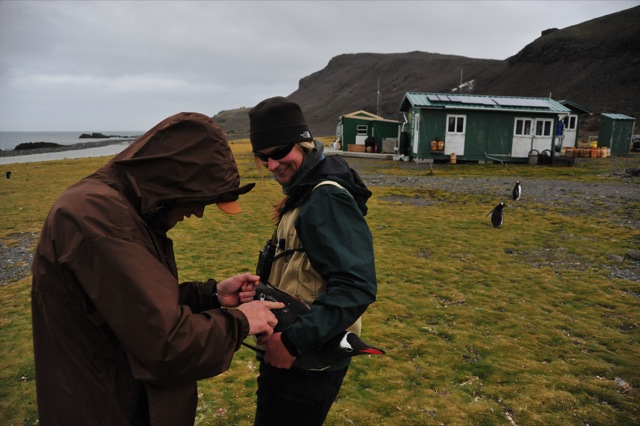

by Kristen Green, Ichthyology Lab
Before leaving my Antarctic camp last spring, we still had biological work to do which was a welcome break from the monotony of packing. The first was a last ditch effort to retrieve the last missing transmitter on a Chinstrap penguin. The satellite data indicated the bird was still coming to shore; sometime between 10 pm and 1 am, and somewhere in a three mile stretch of coastline between Demay and Patelnia. Dave planned to search at Patelnia and then walk back to Demay at midnight. My job was to search the colonies at Demay.
By 11 pm, I was starting to feel my headlamp wasn’t quite sufficient in illuminating the distance I would have liked from fur seals. Surrounded by low guttural warning growls as I picked my way to the penguin colonies, I hailed Dave on the radio and was relieved to hear that he was on his way back. He too, was tired of waiting in the cold, navigating through minefields of territorial fur seals. We returned empty handed, morale sinking further as we tried to decipher Polish cooking instructions on the food stored at the tiny, unheated Polish refugio where we planned to stay the night. Later in the week the next satellite download revealed the transmitter had stopped transmitting signals all together, but at least we tried.

Our final biological task was to count and band giant petrel chicks. Of the birds we work with, giant petrels are the most sensitive to disturbance. The chicks need to be old enough to fend for themselves since the parents will fly off immediately when we approach the colony. These are the largest birds we handle; the adults are about 25 lbs; the chicks are like big fuzzy 15 lb dough balls.
Despite their size, the giant petrels are primarily scavengers, and their defense mechanism is to project an oily vomit onto potential attackers. The best way to avoid this is to approach within 10 ft of a nest, and then sprint the last few feet to the nest, grabbing the chick quickly and holding the beak so it can breathe, but not regurgitate on the lucky person doing the banding. Giant petrels are known for their strong site fidelity, often returning to the same colony and the same nest each year. The bands help us to estimate this site fidelity, as well as measure over winter survival. This year’s chicks will fledge in about a month, and then live on the open ocean for the next 5 years before returning to the island to breed.

The bird work was done, but the chaos of packing continued. Sitting in the hut the night before we were scheduled to leave, surrounded by plastic bags with a laundry list of things to still accomplish, we found out via radio call that the ship was going to be delayed a full day. They needed better weather to offload researchers at another island field camp about 12 hours away. The gift of this extra day was a blessing, not only in needed time to finish closing camp, but also for me in being able to say goodbye to the island.


